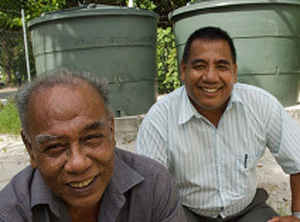Joint Australia – World Bank assistance in Kiribati is helping secure stable supplies of fresh water. Photo: Lorrie Graham, AusAID
The World Bank has been instrumental in facilitating a range of important climate change and environment funding mechanisms–including the Global Environment Facility, the Climate Investment Funds and the Forest Carbon Partnership Facility [external website]. This involvement has been in response to unprecedented demand from many countries for support in their efforts to address development and climate change challenges. Australia is contributing to these funds to ensure its support is coordinated and effective in addressing climate change issues.
The Forest Carbon Partnership Facility, in particular, will set the stage for a large-scale system of incentives for reducing emissions from deforestation and forest degradation, providing a fresh source of financing for the sustainable use of forest resources and biodiversity conservation, and for the more than 1.2 billion people who depend, to varying degrees, on forests for their livelihoods.
Engagement with the World Bank is an important part of Australia's environmental and climate change agenda. In 2011–12 environmental and climate change activities accounted for approximately 5 per cent of Australia's total overseas development assistance budget, or approximately $231 million.
Holding back the tide–building resilience to climate change
The nation of Kiribati, a chain of small, mostly low-lying, coral islands, is one of the most vulnerable countries in the world to the effects of climate change and natural disasters. Many coastal villages are at risk of submersion by 2050. Australia and the World Bank are working together to help both the government and local communities prepare for some of the climate-related challenges [video, external website].
Two of the most pressing problems being addressed by this program are the need to protect against coastal erosion and to secure stable supplies of fresh water. Tides have already flooded homes and devastated people's livelihoods, and sea-level rise is already contaminating groundwater, making it unfit for people to drink.
In an effort to combat coastal erosion and predicted sea-level changes, sea walls have been built along the main road and more than 37,000 mangrove seedlings have been planted. Improvements to the water supply have already directly benefited more than 1,200 people, and work is currently under way to increase storage capacity and water management. Together, these efforts are increasing resilience to the effects of climate change for Kiribati's 110,000 residents.
Working together on water resource management
More than 750 million people depend on flows from the Ganges, Brahmaputra and Indus rivers for agriculture and food security, industry and power, safe water and sanitation, and to sustain environmental ecosystems in the region. Photo: Dirk Guinan, AusAID
In South Asia, as water flows in the Himalayan river basins become less predictable due to the impacts of climate change, regional cooperation on water resource management is critical. More than 750 million people depend on flows from the Ganges, Brahmaputra and Indus rivers for agriculture and food security, industry and power, safe water and sanitation, and to sustain environmental ecosystems in the region.
The World Bank and Australia are working with the United Kingdom and Norway through the South Asia Water Initiative to build knowledge and institutions, and to promote information-based dialogue within countries, across basins and throughout the region.
This initiative is helping to improve the resilience to the impacts of climate change in the river basins of South Asia and has already completed activities that include:
- the first comprehensive analysis of the Ganges River system to inform policy makers that manage the river across borders in Bangladesh, India and Nepal
- social and environmental impact assessments to help management of the world's largest mangrove system, the Sundabarns, in Bangladesh and India
- integrated river basin planning in Afghanistan to support the prioritisation of resources and increase resilience to climate change.
Australian institutions, including the Commonwealth Scientific and Industrial Research Organisation (CSIRO), and Australian water experts are working closely with development partners to improve human resource capacity and program designs.


